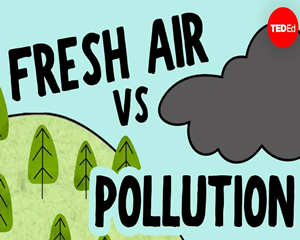Take a deep breath. In that single intake of air, your lungs swelled with roughly 25 sextillion molecules,
深呼吸。每当你吸入一口空气,你的肺里充满了大约25乘以10的21次方个分子,
ranging from compounds produced days ago, to those formed billions of years in the past.
有的化合物是几天前刚刚形成的,有的却已经存在了数十亿年。
In fact, many of the molecules you're breathing were likely exhaled by members of ancient civilizations and innumerable humans since.
事实上,很多你吸入的分子,很可能是古人曾经呼出的,并且经过了无数人的呼吸。
But what exactly are we all breathing? Roughly 78% of Earth's atmosphere is composed of nitrogen generated by volcanic activity deep beneath the planet's crust.
但我们呼吸的空气里到底有什么呢?氮气构成了约78%的地球大气层,这些氮气是地底火山活动产生的。
The next major ingredient is oxygen, accounting for 21% of Earth's air.
另一个主要成分是氧气,它占地球空气的21%。
While oxygen molecules have been around as long as Earth's oceans, oxygen gas didn't appear until ocean dwelling microorganisms evolved to produce it.
虽然早在地球有海洋的时候氧分子就出现了,但在海洋微生物进化到可以产生氧气时,氧气才出现。
Finally, .93% of our air is argon, a molecule formed from the radioactive decay of potassium in Earth's atmosphere, crust, and core.
最后,我们的空气中有0.93%是氩气,地球大气、地壳和地核中的钾元素,进行放射性衰变,从而形成了钾分子。
Together, all these dry gases make up 99.93% of each breath you take.
所有这些干燥气体合在一起,占每次呼吸的99.93%。
Depending on when and where you are, the air may also contain some water vapor.
由于你所处的时间和地点不同,空气中可能还含有一些水蒸气。
But even more variable is that remaining .07%, which contains a world of possibilities.
但更大的变数是剩下的0.07%,这是一个充满可能性的世界。
This small slice of air is composed of numerous small particles including pollen, fungal spores, and liquid droplets, alongside trace gases like methane and carbon dioxide.
这一小部分空气由许多小颗粒组成,包括花粉、真菌孢子和液滴,以及甲烷和二氧化碳等微量气体。
The specific cocktail of natural and man-made compounds changes dramatically from place to place.
这种由天然和人造化合物组成的特殊混合物,因地而异。
But no matter where you are, .07% of every breath you take likely contains man-made pollutants
但不管你在哪里,你每次呼吸的0.07%都可能含有人造污染物,
potentially including toxic compounds that can cause lung disease, cancer, and even DNA damage.
可能包括能导致肺病、癌症,甚至DNA损伤的有毒化合物。
There's a wide variety of known pollutants but they all fall into two categories.
已知的污染物种类繁多,但它们都可分为两类。
The first are primary pollutants. These toxic compounds are directly emitted from a man-made or naturally occurring source.
一种是原生污染物。这些有毒化合物的直接来源可能是人为的或天然产生的。

However, they don't always come from the places you'd expect.
但是它们的来源可能出乎你的意料。
Some large factories mostly generate water vapor, with only small quantities of pollutants mixed in.
一些大型工厂排放出的主要是水蒸气,仅混入了少量污染物。
Conversely, burning wood or dung can create polycyclic aromatic hydrocarbons; dangerous compounds that have been linked to several types of cancer, as well as long-term DNA damage.
燃烧木材或粪便,反过来,会产生多环芳烃,这种危险的化合物与多种癌症以及长期DNA损伤密切相关。
In all cases, pollutants interact with regional weather patterns and topography, which can keep compounds local or spread them kilometers away.
污染物普遍会与区域气候和地形相互作用,这会使化合物保持在当地范围内,或传播到数公里之外。
When these molecules travel through the air, a transformation occurs.
这些分子在空气中传播时会发生转变。
Natural compounds called oxidants, formed by oxygen and sunlight, break down the pollutants.
有一种天然化合物叫氧化剂,它是由氧气和阳光形成的,氧化剂可以分解污染物。
Sometimes, these reactions make pollutants more easily washed out by rain.
有时这些反应会使污染物更容易被雨水冲走。
But in other cases, they result in even more toxic secondary pollutants.
但在其他情况下,它们也会导致毒性更大的二次污染物。
For example, when factories burn coal, they release high concentrations of sulfur oxides.
例如工厂燃烧煤炭时,会释放出高浓度的硫氧化物。
These molecules oxidize to form sulfates, which condense with water vapor in the air to form a blanket of fine particles that impair visibility and cause severe lung damage.
这些分子氧化形成硫酸盐,与空气中的水蒸气凝结形成一层细小的颗粒状物质,不仅降低能见度,还会对人体肺部造成严重损伤。
This so-called sulfurous smog was well-known in 20th century London and continues to plague cities like Beijing.
这种所谓的硫磺烟雾在20世纪的伦敦广为人知,并持续困扰着北京等城市。
Since the advent of cars, another secondary pollutant has taken center stage.
自汽车问世以来,另一种二次污染物占据了中心位置。
Exhaust from fossil fuel-burning vehicles releases nitrogen oxides and hydrocarbons which react to form ozone.
燃烧化石燃料的车辆排放的废气中包含了氮氧化物和碳氢化合物,它们会发生反应形成臭氧。
And while some ozone in the upper atmosphere helps shield us from ultraviolet rays,
虽然上层大气中的臭氧有助于保护我们免受紫外线的伤害,
on the ground, this gas can form alongside secondary particles and create photochemical smog.
但在地面上,这种气体会与次级粒子一起形成光化学烟雾。
This brown fog can be found covering densely packed cities, making seeing difficult and breathing hazardous.
这种棕色的雾往往会笼罩于人口集中的城市上空,有碍于视线,甚至造成呼吸困难。
It also contributes to climate change by trapping heat in the atmosphere.
它还在大气中吸收热量,引起气候变化。
In recent decades, industrial activity has contributed to a huge spike in various trace gas emissions, fundamentally changing the air we all breathe.
近几十年来,工业活动导致各种微量气体的排放量激增,从根本上改变了我们所有人呼吸的空气。
Many places have already responded with countermeasures.
许多地方已经采取了应对措施。
Most cars produced since the 1980's are equipped with catalytic converters that reduce the emission of carbon monoxide and nitrogen oxides.
自20世纪80年代以来生产的大多数汽车都配备了催化转化器,可以减少一氧化碳和氮氧化物的排放。
And today, places like Beijing are battling smog by electrifying their energy infrastructure and limiting automobile emissions altogether.
如今北京等地正在通过为其能源基础设施供电和限制汽车排放来对抗雾霾。
But while moving away from fossil fuels is essential, there's no universal remedy for air pollution.
虽然远离化石燃料是必不可少的,但对于空气污染,尚未有普适的补救措施。
Different regions need to respond with unique regulations that account for their local pollutants. Because no matter where you live, we all share the same air.
不同地区需要针对当地的污染物制定特定的法规。因为无论你住在哪里,我们都分享着同样的空气。


